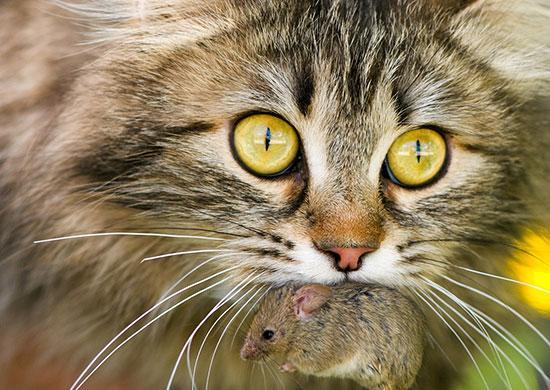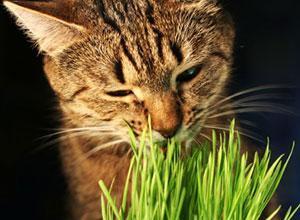This content is archived from the Feline Nutrition Foundation
Answers: The Stomach Contents of Prey
- Updated: Monday, May 06, 2019 04:19 PM
- Published: Saturday, July 16, 2011 01:51 PM
- Written by Lyn Thomson, BVSc DipHom
 I've read that cats get nutrients and roughage from the stomach contents of their prey. But, I have also read that cats will avoid eating the stomach and intestines of larger prey, such as rabbits. Do cats benefit from eating the stomach contents of small prey such as mice? If so, should something be supplemented in raw cat food to make sure they are getting everything they need?
I've read that cats get nutrients and roughage from the stomach contents of their prey. But, I have also read that cats will avoid eating the stomach and intestines of larger prey, such as rabbits. Do cats benefit from eating the stomach contents of small prey such as mice? If so, should something be supplemented in raw cat food to make sure they are getting everything they need?
Cats tend to consume the whole of a small prey animal like a mouse, with its tiny amount of fermented stomach content. I have seen cats eat the stomach content of larger prey like rabbits, and have also seen them leave it. The stomach content of an herbivore, such as a mouse or rabbit, contains fermented vegetable matter that is a mix of symbiotic bacteria and volatile fatty acids.¹ The VFAs become the energy source for the herbivorous animal and the symbiotic bacteria. In turn, the symbiotic bacteria keep the intestinal mucosa healthy.
So, for a cat, the consumption of fermented gut content from a mouse or rabbit aids in the management of the cat's own intestinal flora. The intestinal flora in turn maintains the integrity of the mucosal surface. It is likely the VFAs contribute little as an energy source to the cat, but the bacterial load is likely beneficial.² The microorganisms perform a host of useful functions: preventing the growth of harmful bacteria, producing vitamins for the host such as biotin and vitamin K and maintaining the integrity of the mucosal surface of the gut.³
 As an obligate carnivore hunting and consuming prey, he will get this dose of beneficial bacteria naturally when he consumes the entire prey. If he is free ranging and digs in soil to do his toileting, he may then consume small amounts of soil bacteria when grooming himself or may eat plant matter that has a bacterial load. These bacteria are beneficial in the same way as stomach content bacteria.
As an obligate carnivore hunting and consuming prey, he will get this dose of beneficial bacteria naturally when he consumes the entire prey. If he is free ranging and digs in soil to do his toileting, he may then consume small amounts of soil bacteria when grooming himself or may eat plant matter that has a bacterial load. These bacteria are beneficial in the same way as stomach content bacteria.
If he is an indoor cat, he may consume an equivalent to the stomach content in his ground commercial raw cat food. In some countries, green tripe is added to the ground mix. Green tripe is the unwashed stomach and its content from a ruminant animal such as a sheep or cow. Green tripe contains fermented grass full of VFAs and symbiotic bacteria. If you are formulating a diet at home, you can grow grasses in pots for your cats to chew on and get their fix of soil bacteria.
Additional Reading
Answers: Your Cat's Acid Stomach
High Pressure Processing: The Future of Raw Cat Food?
Beneficial bacteria can also be given as probiotic supplements. For cats, it is rarely necessary to provide a probiotic supplement, but it can be important if your cat has recently been on antibiotics or has a digestive upset. Probiotic supplements come in powders, capsules and pastes and usually contain a combination of symbiotic bacteria.
Note: Feline Nutrition provides feline health and nutrition information as a public service. Diagnosis and treatment of specific conditions should always be in consultation with your own veterinarian. Feline Nutrition disclaims all warranties and liability related to the veterinary advice and information provided on this site.
Dr. Lyn Thomson trained at the University of Bristol in England and is studying with the Australasian College of Nutritional and Environmental Medicine. A dedicated and experienced advocate of bio-appropriate nutrition, Lyn practices in Auckland, New Zealand. HerRaw Essentialsstores have grown to seven retail locations, providing a variety of raw diet products for cats and dogs.
1. "Animal Structure and Function," The University of Waikato, Hamilton, New Zealand.
2. B.P. Brosey, R.C. Hill and K.C. Scott, "Gastrointestinal Volatile Fatty Acid Concentrations and pH in Cats," American Journal of Veterinary Research 61, no. 4, April 2000, 359-361.
3. R. Fuller, "Probiotics in Man and Animals," The Journal of Applied Bacteriology 66, no. 5, May 1989, 365-378.




